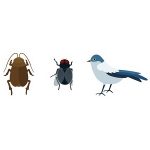If you were given the option to run a long-distance relay race, would you select four runners to split up the distance or would you choose to run it alone? That’s a no-brainer—you’d pick four runners to give yourself the best chance of success every time!
Apply the same mentality to your food safety program, and (by extension) your pest management program. The only way you’re going to be able to effectively monitor an entire facility is by establishing a team to help. Otherwise, that’s a lot of ground for just one person to cover.
As a food processing facility, you probably already have an integrated pest management (IPM) program in place. But does your staff know the telltale signs of rodents or stored product pests? Would they be able to spot cockroaches crawling around in your facility’s storage area? The earlier you can spot a pest problem, the quicker it can be resolved before it turns into a major issue that could prove costly.
Staff training is the best way to get everybody on the same page when it comes to pest management, because pests are great at hiding and living in hard-to-reach locations. It takes a trained eye to spot certain pests, and informed employees can be a great help to this.
Before you begin staff training, you will want to identify all of the areas both inside and outside of your building that are at high risk for pest issues. Schedule a meeting with your pest management provider and make note of the high-risk areas and the most common pests your facility may be prone to. Once you’ve determined these high-risk areas and the best tactics to protect against them, employee training is a logical next step.
The bigger your facility, the tougher it is to manage all of the different potential hot spots. Everybody knows this, but few consider what this means for their pest management programs. Creating an educational pest program for employees is critical to protecting your facility. The employees are on the ground level and are often the most likely spot the early signs of a pest problem.
Step 1: Start with the Basics
When beginning staff training, make sure employees understand the IPM program in place and how it works in your facility. Many pest control providers offer complimentary employee training, so reach out to your provider about on-site training sessions. As employees learn more about what each tactic does to prevent pest issues, they’ll get a better understanding of why pests get into the facility in the first place. Once informed, they can use this knowledge to help reduce potential risk factors such as standing water from a leak, food waste in processing areas and waste removal.
Here are a few telltale signs of some common pests:
- Stored product pests: Though generally tough to spot, there are some common telltale signs you can spot on products like webbing, larvae, live adults—some of which can look like grain products—and, of course, damaged packaging.
- Flies: If you see larvae (maggots), especially around drains and in other damp or wet areas, it’s time to act fast. Flies reproduce quickly, so small problems can escalate rapidly.
- Cockroaches: They can be found behind or under equipment, wall voids, or any other protected area. Cockroaches will take advantage of nearly any food source!
- Rodents: These pests leave droppings constantly, so watch out for tiny pellets. Rodents are constantly gnawing, so if you see any products with gnaw marks, that’s a good indication that rodents may be present.
A pest management provider can identify what challenges are unique to your facility and which areas are most likely to experience pest activity. Employees are going to be a crucial part of this process, so they will need to know where to look.
Step 2: Designate Roles
Employees are the eyes and ears of your business. Whether it’s pest problems or any other issues at your facility, your staff is probably going to notice issues before management does. Once they know the pests to look out for, they can also keep an eye on:
• Cracks and openings: Any opening that leads from the inside to the outside may allow pests in.
• Sanitation issues: From large bins of food waste, to break room trash cans, let them know to report when these are overflowing or need to be cleaned.
The key is once employees know what to look for, they need to know how and who to report it to. Make sure there is a pest sighting log and employees know where it is and what information to record.
Step 3: Emphasize Communication
Communication is key. We all know that. Which is why it’s so important to encourage the age-old adage when it comes to potential pest problems: “If you see something, say something!” The longer a pest issue persists, the more likely it is to turn into a costly, potentially hazardous infestation.
Consistent communication between employees, management and pest control providers benefits all parties. It ensures employees are in-the-know about important information and new initiatives while making it easier for managers and pest control professionals to stay a step ahead of invading pests. Designate a point person that employees should go to if they have something they want to talk about and make sure to utilize that pest sighting log!
Open dialogue makes it clear to employees that they are a contributing part of your IPM program. Your employees serve as the first line of defense against pests, so if they see pest activity, it’s incredibly important they feel comfortable escalating it immediately. Tell employees you want and need their input in order for your pest management efforts to be most effective. And don’t forget to solicit feedback—they might even have ideas on how to make the program better!
Step 4: Establish a Pest-Sighting Protocol
There needs to be a clear course of action for any employee who notices a pest or evidence of pests within your facility. You’re in the business of protecting your products, and many pests spread dangerous pathogens everywhere they go.
Establishing a protocol for reporting pests will keep things simple for both employee and manager, as it ensures pest problems are documented and action steps are clear. Should a pest be spotted, make sure employees know to do the following:
- Capture pest(s) for identification if possible. Take pictures if you can’t. The better a pest management professional can see a pest, the more accurately they’ll be able to prescribe a solution.
- Fill out a pest-sighting log and note when, where and how many pests were seen. Imagine this as a crime scene, and your pest management professional is the crime scene investigator.
- Contact management if the issue is severe and needs immediate attention, at which point management should contact their pest management professional. The sooner everyone is on the same page, the quicker you can implement a solution to help prevent pests from compromising your products.
Even the best IPM program can’t keep out every pest trying to get into your facility, which is why it’s so important to establish a pest-sighting protocol. It might also be worth forming an IPM committee to meet on a monthly basis. It’s best if this committee includes members from each department and, if possible, the pest management professional in order to promote ongoing improvements.
Step 5: Ongoing Education
Once you’ve taught your employees the basics of how to spot pests, pest evidence, and how to proceed once they see any, training should not stop there.
Although pests stay relatively the same year to year, your facility won’t. Staying up to date with the latest information can help you proactively prevent pests before they become a threat to your operations. Review monitoring reports with your pest management professional to determine if changes need to occur to focus on new areas, or redouble efforts at a hot spot that hasn’t been resolved yet. Remember: Many pest issues take time to completely manage.
Ask your pest management partner for tip sheets, checklists and other educational materials to stay current, and share them with your employees. Also, keep in mind that different pests thrive in different weather conditions, so adjust your tips for employees seasonally so they know what to look for.
With all staff members consistently armed with the necessary information to help identify hot spots and minimize the risk of pests, you’ll be in great shape for your next audit. Just make sure to document everything being done to help proactively protect products. You’ve got to have proof of your efforts!






